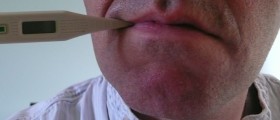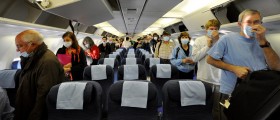
Swine flu or swine influenza is an infection caused by one of the several types of swine influenza viruses. This is a common infection in pigs and transmission of the virus from the pigs to humans is not so typical and does not always include the occurrence of human influenza. In majority of cases people only develop antibodies to the virus without any symptoms and signs of the disease. However, if the infection occurs it is classified as zoonotic swine flu. The greatest risk of swine flu is among people who are exposed to infected animals. The very meat is not a threat unless it is not properly cooked. People who work with poultry and swine are at higher risk of swine flu. They include farm workers as well as veterinarians and meat processing workers. This is why these people must be properly vaccinated and this way the disease can be successfully prevented.
Symptoms and Signs of Swine Flu in Humans
As it has already been mentioned a direct transmission of a swine flu from infected animal to humans is possible. The virus may be more harmful to pregnant women, immunocompromized people and those who are already suffering from other illnesses.
In majority of cases the infection is mild and this is why not all the cases are reported and diagnosed. According to the Centers for Disease Control and Prevention the symptoms and signs of swine flu type H1N1 that have occurred during 2009 are very similar to common symptoms of influenza and influenza-like illnesses. They include increased body temperature, sore throat, cough, body and muscle aches, headaches, chills and fatigue. Some patients have complained about vomiting and diarrhea. The very type H1N1 was transmitted from a person to person and not from animals to humans.
Even though the disease may occur in mild form it may also lead to serious complications such as respiratory failure and subsequent lethal outcome. Several more complications of swine flu include pneumonia, high fever and consequent neurological problems, severe dehydration, electrolyte imbalance and kidney failure. The lethal outcome predominantly affects young children and elderly people.
Treatment and Prevention against Swine Flu
Treatment for swine flu may include antiviral medications which can make the infection milder and help patients to recover faster. Antiviral drugs can also successfully reduce the chance of serious complications. The best effects are achieved if antiviral drugs are administered within 2 days after the onset of the disease. Furthermore, supportive care at home is essential in control of fever, pain, fluid balance and secondary infections. Tamiflu and Relenza are used in treatment and prevention against swine influenza viruses.
The virus is transmitted among humans via coughing and sneezing so prevention includes standard infection control against influenza such as frequent washing of hands with water and soap or alcohol-based hand sanitizers. These maneuvers are particularly recommended after a person has been in public. One is also supposed not to touch his/her eyes, nose or mouth. Anyone who has developed flu-like symptoms such as a sudden fever, cough and muscle pain is supposed to stay away from people at work or public transportation and prevent further transmission of the virus. He/she are also due to contact a doctor for further advice. Today there are vaccines available for this virus and they effectively prevent infection caused by swine flu virus.

















Your thoughts on this
Loading...